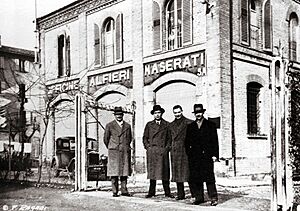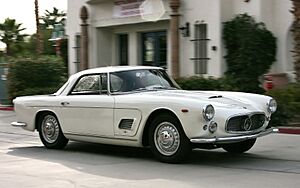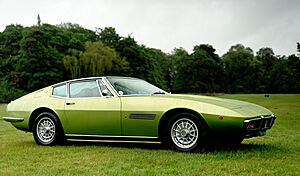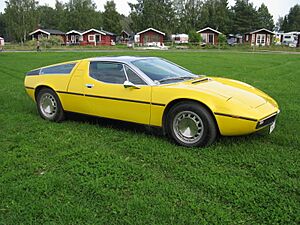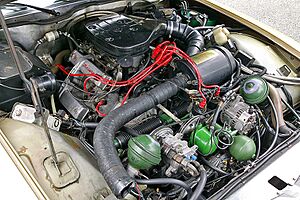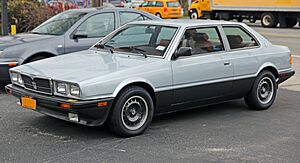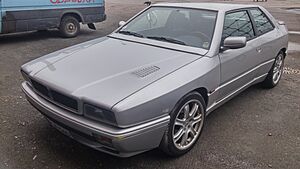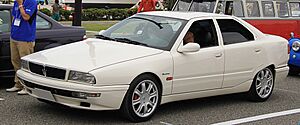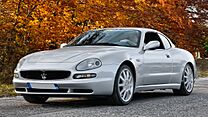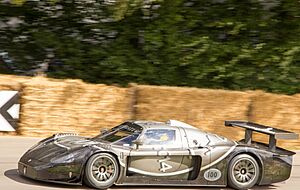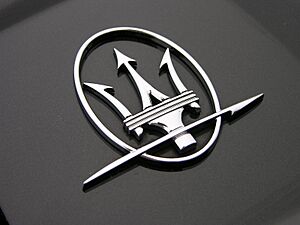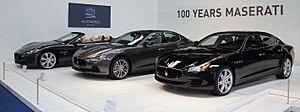Maserati facts for kids
 |
|

Headquarters in Modena, Italy
|
|
| Subsidiary (S.p.A.) | |
| Industry | Automotive |
| Predecessor | Officine Alfieri Maserati S.p.A. |
| Founded | 1 December 1914 Bologna, Italy |
| Founder | Alfieri Maserati |
| Headquarters |
,
Italy
44°38′57″N 10°56′27″E / 44.6493°N 10.9408°E |
|
Area served
|
Worldwide |
|
Key people
|
Davide Grasso (CEO) |
| Products | Luxury vehicles |
|
Production output
|
|
| Revenue | |
|
Number of employees
|
1,100 (2013) |
| Parent | Stellantis |
Maserati S.p.A. is an Italian company that makes fancy, high-performance cars. It started on December 1, 1914, in Bologna, Italy. Today, its main office is in Modena. Maserati's famous symbol is a trident, which is a three-pronged spear. Since 2021, the company has been part of Stellantis.
Maserati has made many popular cars over the years. These include the Maserati Quattroporte, Ghibli, and Maserati GranTurismo. They also make two SUV models, the Maserati Levante and the Maserati Grecale. Maserati aims to produce around 75,000 vehicles globally each year.
History of Maserati
The Maserati Brothers and Early Days
The Maserati company was founded by five brothers: Alfieri, Bindo, Carlo, Ettore, and Ernesto. They all loved cars and started working with them in the early 1900s. In 1926, they created the very first Maserati car. Alfieri Maserati drove one of these early cars to win the 1926 Targa Florio race. Maserati then began building race cars with different types of powerful engines.
The famous trident logo of Maserati was designed by Mario Maserati, one of the brothers who was an artist. It was inspired by the Fountain of Neptune in Bologna. A family friend suggested using this symbol in 1920. It was a great choice because Neptune represents strength and power, which fits a sports car company. Also, the statue is a well-known symbol of Bologna, where the company first started.
Alfieri Maserati passed away in 1932, but his brothers Bindo, Ernesto, and Ettore continued to run the company.
New Ownership and Racing Successes
In 1937, the Maserati brothers sold their shares to the Adolfo Orsi family. In 1940, the company moved its main office to Modena, where it still is today. The brothers stayed on to help with engineering. Maserati continued to win races, even against big German car makers like Auto Union and Mercedes. A Maserati car won the Indianapolis 500 race in both 1939 and 1940. This made Maserati the only Italian car maker to ever win that race.
During World War II, Maserati stopped making cars to produce parts for the war effort. After the war, Maserati went back to making cars, and their A6 series did very well in races.

Important people joined the Maserati team, like engineer Alberto Massimino. He helped design many racing models for the next ten years. Other engineers like Giulio Alfieri also joined. Their main goal was to create the best engines and car frames for racing. The Maserati brothers left the company after their contract with Orsi ended, and they started their own company called O.S.C.A..
A famous Argentinian race car driver named Juan-Manuel Fangio raced for Maserati in the 1950s. He won many races, including the world championship in 1957 in a 250F car.
Maserati Focuses on Road Cars
Maserati stopped participating in factory racing after a serious accident during the 1957 Mille Miglia race. This event made them decide to focus more on building luxury cars for everyday driving, known as grand tourers.
The 1957 3500 GT was a very important car for Maserati. It was their first car designed from scratch as a grand tourer and their first car produced in large numbers. Production jumped from a few dozen cars a year to hundreds. The 3500 GT was very successful, with over 2,200 made. Its success was key to Maserati surviving after they stopped racing.
The 3500 GT also led to the creation of the 5000 GT. This car was one of the fastest and most expensive cars of its time. Later, in the 1960s, Maserati introduced other models like the Sebring, Mistral, and the first saloon car, the Quattroporte.
In 1967, the stylish Ghibli coupé was launched. It had a powerful V8 engine.
Citroën Takes Over
In 1968, the French car company Citroën took over Maserati. Maserati designed and built an engine for Citroën's new car, the SM. Maserati also started using some of Citroën's advanced technology in its cars.
With new financial support, Maserati launched new models. The 1969 Indy was a four-seater luxury car. In 1971, the Bora became Maserati's first car with its engine placed in the middle. This design made Maserati cars more modern. The Bora was followed by the Merak in 1972.
Maserati also developed the Quattroporte II, a large luxury car. However, only a few of these were ever made. The Khamsin was another grand tourer introduced in 1972.
Tough Times for Maserati
The 1973 oil crisis made things difficult for car companies. People bought fewer fuel-hungry sports cars. Maserati was hit hard because more than half of its sales were in Italy, where car sales dropped a lot. In 1974, Citroën faced financial problems and decided to close Maserati.
However, workers, local leaders, and government officials worked together to save the 800 jobs at Maserati. An agreement was reached to keep the company going.
The De Tomaso Era
On August 8, 1975, Maserati was bought by an Italian state-owned company called GEPI and Alejandro de Tomaso, a businessman and former race car driver. De Tomaso became the head of Maserati.
New Maserati models were introduced starting in 1976. These cars shared parts with De Tomaso's own cars, but used Maserati's engines. The Kyalami grand tourer and the Quattroporte III were among these new cars.
The Biturbo Car Family
The 1980s brought a big change for Maserati with the introduction of the Biturbo. This was a smaller, more affordable car with its engine in the front. Its special feature was its twin-turbocharged V6 engine, which was a first for a production car. Many new Maserati models in the 1980s and 1990s were based on the Biturbo's design.
The Biturbo family was very popular, selling 40,000 units. Maserati expanded the Biturbo range to include saloons and cabriolets. In 1984, Chrysler bought a small share in Maserati, and the two companies worked together to produce a car for the American market, the Chrysler TC by Maserati.
New Biturbo-based cars were launched every year. The Biturbo name was eventually dropped, and the cars were updated and renamed. In 1989, Maserati brought back an eight-cylinder grand tourer called the Shamal. It had a powerful new twin-turbocharged V8 engine.
De Tomaso and FIAT Partnership
In October 1989, De Tomaso bought the remaining shares from GEPI. Then, in December, FIAT became involved with Maserati. FIAT owned 49% of the new Maserati S.p.A. company.
In the early 1990s, Maserati developed a new mid-engine sports car called the Chubasco, but the project was cancelled. The Ghibli II was introduced in 1992. It was a six-cylinder coupé with a powerful twin-turbocharged V6 engine.
FIAT Takes Full Control
On May 19, 1993, Alejandro De Tomaso sold his remaining shares to FIAT, making FIAT the sole owner of Maserati.
In 1994, the Quattroporte IV replaced the older Quattroporte model. It was available with both V6 and V8 engines.
Years later, Maserati and Chrysler became connected again when FIAT bought most of Chrysler in 2011. In 2021, FIAT Chrysler Automobiles (FCA) merged with the French PSA Group to form Stellantis, which brought Maserati and Citroën back together.
Maserati and Ferrari
In July 1997, FIAT sold half of Maserati to Ferrari, which was also owned by FIAT. By 1999, Ferrari had full control of Maserati, making it their luxury car division. A new factory was built in Modena.
In 1998, Maserati launched the 3200 GT, a two-door coupé with a powerful twin-turbocharged V8 engine. In 2002, the 3200 GT was replaced by the Maserati Coupé and Spyder. These cars used a new V8 engine. Later, the Coupé and Spyder were replaced by the GranTurismo and GranCabrio.
Two new models were also introduced: the MC12 super sports car and the new Quattroporte luxury saloon. In 2001, Ferrari updated the Modena factory with new technology.
Since early 2002, Maserati returned to selling cars in the United States, which quickly became its biggest market. The company also returned to racing with its Trofeo cars and the MC12. The MC12 was very successful in the FIA GT championship, winning team championships from 2005 to 2007. Only 50 street-legal MC12 models were sold.
Maserati and Alfa Romeo Group
In 2005, Maserati was separated from Ferrari and partnered with Alfa Romeo under the FIAT Group. In the middle of 2007, Maserati made a profit for the first time in 17 years under FIAT ownership.
In 2010, FIAT created a new group for Alfa Romeo, Maserati, and Abarth, led by Harald J. Wester. The goal was to combine the sporty and high-performance qualities of these brands.
In 2013, Maserati began to grow with the launch of the Quattroporte VI, designed to compete with other luxury cars. This was followed by the Ghibli. In 2014, Maserati confirmed it would produce the Levante SUV and the Alfieri concept sports car. The GranTurismo and GranCabrio models continued production until November 2019.
Maserati also re-entered the high-performance car market. Their top models, like the Quattroporte VI, Ghibli, and Levante, have powerful V8 engines and all-wheel drive to compete with other luxury sports car brands.
Maserati's sales increased significantly in 2013 and 2014. In 2014, Maserati sold about 36,500 cars worldwide, a big increase from the previous year. Maserati aims to stay in the high-end luxury sports car market.
In 2014, Fiat S.p.A. merged with Chrysler to form Fiat Chrysler Automobiles. Later, in 2021, FCA merged with the French PSA Group to form Stellantis, bringing Maserati and Citroën together again.
Electric Future
On March 17, 2022, Maserati's CEO, Davide Grasso, announced that Maserati will make an electric version of all its models by 2025. He also shared plans to stop making cars with traditional engines by 2030. All electric Maseratis will be called "Folgore," which means "lightning" in Italian.
Maserati Cars Today
- See List of Maserati vehicles for a complete historical list
Current Models
| MC20 MC20 Cielo |
Grecale | GranTurismo GranCabrio |
|---|---|---|
|
|
|
Maserati MC20
The Maserati MC20 is a two-door sports car with its engine in the middle. It was first shown in September 2020. The car is built with a strong, lightweight carbon fiber frame and has a 3-liter V6 engine that produces 630 horsepower.
Maserati Grecale
The Maserati Grecale is a five-door, five-passenger luxury SUV. It shares its main structure with other cars like the Alfa Romeo Stelvio. It comes with different engine options, including mild hybrid four-cylinder engines and a powerful 530 horsepower V6 Nettuno engine for the Trofeo version.
Maserati GranTurismo
The Maserati GranTurismo is a luxury grand tourer car that was first introduced in 2007. The first generation had a 4.7-liter V8 engine. A convertible version, called the GranCabrio, was also available. The production of the first GranTurismo ended in November 2019.
The second generation GranTurismo was revealed online in 2022 and started production in April 2023. It offers a 3-liter V6 engine, similar to the MC20, with different power levels. There is also an electric version called the Folgore, which has three motors and produces 761 horsepower.
Motorsport Activities
Throughout its history, Maserati has been involved in many types of car racing. This includes Formula One, sportscar racing, and touring car racing. Famous drivers like Juan Manuel Fangio have raced for Maserati.
Maserati also developed special GranTurismo MC racecars for competitions. On January 10, 2022, Maserati announced that it would join Formula E, an electric racing series, in the 2022–23 season.
Images for kids
-
Headquarters in Modena, Italy
-
Juan-Manuel Fangio driving a Maserati 250F
See also
 In Spanish: Maserati para niños
In Spanish: Maserati para niños


